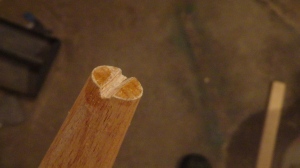I’ve been thinking about building a washtub bass for a while. Down the road there are some folks who apparently use washtubs for recycling containers. On my way to work, I’d see them out by their garage next to their garbage can and hope they were going to throw them away. No such luck. I kept checking places that were close to home, but couldn’t find anywhere close to buy a new one either. One day I had to make a last minute run to Stillwater to pick up instruments parts. I was preparing for a craft show, and had neglected to make sure I had enough tuners. I took the trip out there to pick some up, and on my way back noticed a Fleet Farm. I knew they would have washtubs, so I swung back around to check it out.
I grabbed a 14 gallon galvanized tub. I think they’re actually considered feed tubs, but I’ll be referring to it as a washtub from here on out. Then I headed over to hardware where I grabbed the shortest 3/8″ eye bolt I could find. I got the two largest fender washers I could find, a couple lock washers, and a nylon package of nylon lock nuts. The last thing I grabbed was a 60″ hardwood handle. I knew I had a couple broom handles at home, but I figured I might want something a little longer and a little thicker. I also knew that I had some clothesline at home. I’d purchased it before a camping trip for making a makeshift shade canopy. A tree worked pretty well as a shade canopy, so it had never been used.
At home the first thing I did was drill a 3/8 inch hole in the center of the bottom of the washtub. I set it on a piece of scrap plywood and drilled from inside the tub. I actually have a Forstner bit that I use strictly for thin metal because it makes a nicer hole than a standard twist bit. Either one will work though.
Next thing I did was take off the handles. Some people cut them off. I just grabbed the handle with a slip joint pliers (what everyone refers to as channel locks) and twisted it out.
Next I installed the eyebolt. It came with a nut which I turned on as far as it would go. Then I put on a lock washer and a large fender washer. I slid it into the hole in the washtub (from the underside) and then put on another large fender washer, a lock washer and then a nylon lock nut. This might be overkill, but for the price a couple extra lock washers I’d rather just make sure that it doesn’t come loose. Don’t skip the fender washers though. They spread the tension over a larger area. Without them, I imagine that nut would eventually work its way through the bottom of the washtub.

Next I got my “neck” ready. First a drilled a 1/4” hole a couple inches from the top of the handle. Next you have to cut a slot in the bottom to slip over the edge of the washtub. You want to make sure that the slot is perpendicular to the hole. I slipped a pencil in the hole and then propped it on a nut to hold the hole horizontal. Then I could cut the slot vertical and everything would be lined up correctly. Again I just eyeballed it. I made two vertical cuts maybe 1/4 inch apart, pretty much just enough to score the wood. Once I had the wood scored, it didn’t matter if I turned the handle to get a better angle for cutting. Starting at each cut, I cut diagonally toward the middle to open up a slot. Once you have it cut, just make sure it fits over the rim of the washtub when it’s turned upside down. You want the slot deep enough that it will stay on the rim, but not so deep that the handle touches the bottom of the washtub.
The last thing to do was add the ‘string.’ There’s some debate about what kind of string sounds best. Some folks swear by weedwacker line, some like airline cable or parachute cord. I had cotton clothesline, so I went with that. I tied it to the eyebolt, and then passed it through the hole in the handle. I slipped the slot over the rim and tipped the handle until the string was vertical when pulled taught. I marked where it passed through the handle and then tied a knot there. Actually, I didn’t tie a “knot” because I knew the clothesline would stretch, so I left a loop so it would be easy to untie and retie when it was needed.









